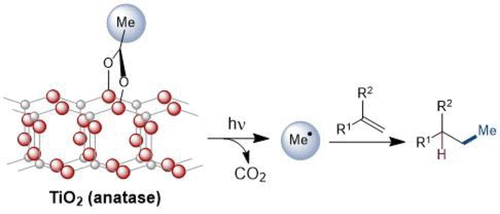当前位置:
X-MOL 学术
›
J. Am. Chem. Soc.
›
论文详情
Our official English website, www.x-mol.net, welcomes your
feedback! (Note: you will need to create a separate account there.)
Photocatalytic Hydromethylation and Hydroalkylation of Olefins Enabled by Titanium Dioxide Mediated Decarboxylation
Journal of the American Chemical Society ( IF 14.4 ) Pub Date : 2020-09-18 , DOI: 10.1021/jacs.0c08688 Qilei Zhu 1 , Daniel G Nocera 1
Journal of the American Chemical Society ( IF 14.4 ) Pub Date : 2020-09-18 , DOI: 10.1021/jacs.0c08688 Qilei Zhu 1 , Daniel G Nocera 1
Affiliation

|
A versatile method for the hydromethylation and hydroalkylation of alkenes at room temperature is achieved by using the photooxidative redox capacity of the valence band of anatase titanium dioxide (TiO2). Mechanistic studies support a radical-based mechanism involving the photoexcitation of TiO2 with 390-nm light in the presence of acetic acid and other carboxylic acids to generate methyl and alkyl radicals, respectively, without the need for stoichiometric base. This protocol is accepting of a broad scope of alkene and carboxylic acids, including challenging ones that produce highly reactive primary alkyl radicals and those containing functional groups that are susceptible to nucleophilic substitution such as alkyl halides. This methodology highlights the utility of using heterogeneous semiconductor photocatalysts such as TiO2 for promoting challenging organic syntheses that rely on highly reactive intermediates.
中文翻译:

二氧化钛介导的脱羧使烯烃光催化加氢甲基化和加氢烷基化
通过使用锐钛矿二氧化钛 (TiO2) 价带的光氧化氧化还原能力,实现了一种在室温下进行烯烃氢甲基化和氢烷基化的通用方法。机理研究支持基于自由基的机制,涉及在乙酸和其他羧酸存在下用 390 nm 光光激发 TiO2 分别生成甲基和烷基自由基,而不需要化学计量的碱。该协议接受范围广泛的烯烃和羧酸,包括具有挑战性的那些产生高反应性伯烷基自由基的物质和那些含有易受亲核取代(如卤代烷)影响的官能团的物质。
更新日期:2020-09-18
中文翻译:

二氧化钛介导的脱羧使烯烃光催化加氢甲基化和加氢烷基化
通过使用锐钛矿二氧化钛 (TiO2) 价带的光氧化氧化还原能力,实现了一种在室温下进行烯烃氢甲基化和氢烷基化的通用方法。机理研究支持基于自由基的机制,涉及在乙酸和其他羧酸存在下用 390 nm 光光激发 TiO2 分别生成甲基和烷基自由基,而不需要化学计量的碱。该协议接受范围广泛的烯烃和羧酸,包括具有挑战性的那些产生高反应性伯烷基自由基的物质和那些含有易受亲核取代(如卤代烷)影响的官能团的物质。











































 京公网安备 11010802027423号
京公网安备 11010802027423号